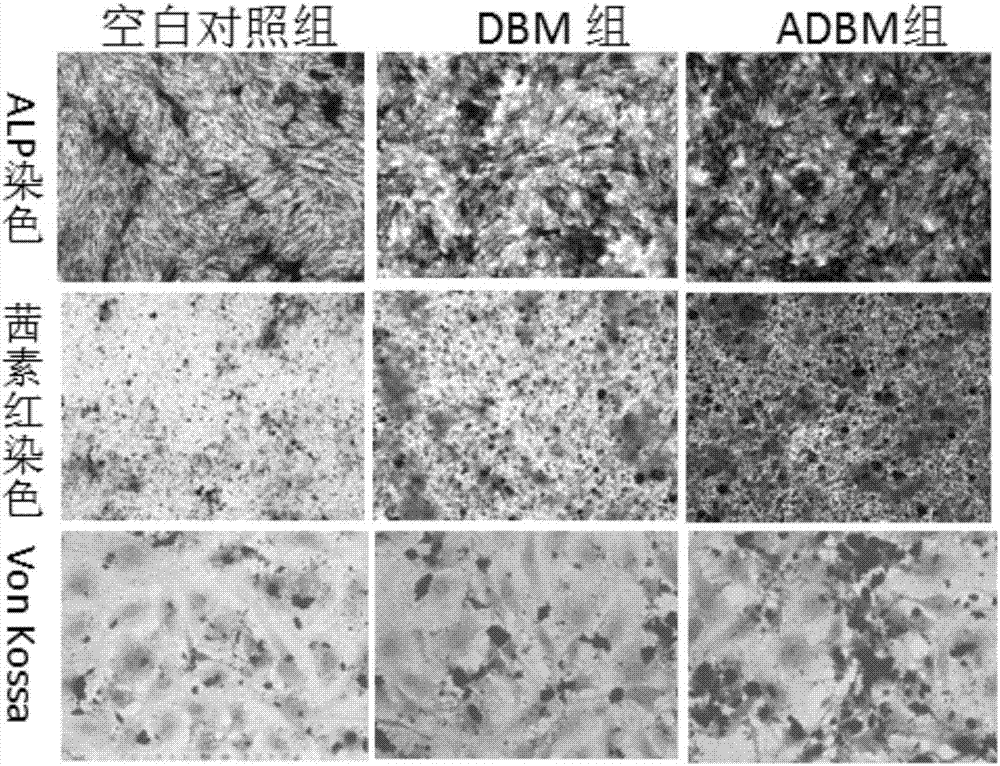Preparation method of decalcified bone matrix bone-repairing material
A technology for decalcified bone matrix and bone repair, applied in prosthesis, tissue regeneration, medical science, etc., can solve the problems of poor plasticity, poor polymerization, unsuitable for filling, etc., achieve good swelling capacity and degradation performance, and preparation process The process is simple and the effect of solving irregular bone defects is solved
- Summary
- Abstract
- Description
- Claims
- Application Information
AI Technical Summary
Problems solved by technology
Method used
Image
Examples
Embodiment 1
[0029] 1) Add 1 g of sodium alginate to 100 ml of phosphate buffer solution with a pH of 7, stir and mix evenly to obtain a sodium alginate solution with a weight to volume ratio of 1%;
[0030] 2) Add the decalcified bone matrix powder into the sodium alginate solution, stir well to make a suspension with the concentration of the decalcified bone matrix powder at 25 mg / ml, and store it at 4°C for later use;
[0031] 3) Prepare CaCl with a weight concentration of 2% with double distilled water 2 solution, the suspension in step 2) is placed in a cylindrical mold, and CaCl is slowly added dropwise to the suspension 2 solution until the suspension gelled (CaCl 2 The addition amount of the solution is 3.5% of the suspension volume), then take out the strip gel from the mold after standing for 1 hour;
[0032] 4) Freeze-dry the strip-shaped gel. The freeze-drying procedure is as follows: first freeze at -80°C for 12 hours, then immediately transfer to a vacuum freeze-dryer, set ...
Embodiment 2
[0035] 1) Add 0.5 g of sodium alginate to 100 ml of phosphate buffer solution with a pH of 6.5, stir and mix evenly to obtain a sodium alginate solution with a weight to volume ratio of 0.5%;
[0036] 2) Add the decalcified bone matrix powder into the sodium alginate solution, stir well to make a suspension with the concentration of the decalcified bone matrix powder at 20 mg / ml, and store it at 4°C for later use;
[0037] 3) Prepare CaCl with a weight concentration of 1% with double distilled water 2 solution, the suspension in step 2) is placed in a mold, and CaCl is added dropwise to the suspension 2 Solution (CaCl 2 The amount of solution added is 5% of the volume of the suspension), until the suspension gels, and then after standing for 2 hours, the strip gel is taken out from the mold;
[0038] 4) Freeze-dry the strip-shaped gel to obtain the product.
Embodiment 3
[0040] 1) Add 2 g of sodium alginate to 100 ml of phosphate buffer solution with a pH of 8, stir and mix evenly to obtain a sodium alginate solution with a weight-to-volume ratio of 2%;
[0041] 2) Add the decalcified bone matrix powder into the sodium alginate solution, stir well to make a suspension with the concentration of the decalcified bone matrix powder at 50 mg / ml, and store it at 4°C for later use;
[0042] 3) Prepare CaCl with a weight concentration of 3% with double distilled water 2 solution, the suspension in step 2) is placed in a mold, and CaCl is added dropwise to the suspension 2 solution until the suspension gels, then remove the strip gel from the mold after standing for 1 hour;
[0043] 4) Freeze-dry the strip-shaped gel to obtain the product.
PUM
| Property | Measurement | Unit |
|---|---|---|
| concentration | aaaaa | aaaaa |
Abstract
Description
Claims
Application Information
 Login to View More
Login to View More - R&D
- Intellectual Property
- Life Sciences
- Materials
- Tech Scout
- Unparalleled Data Quality
- Higher Quality Content
- 60% Fewer Hallucinations
Browse by: Latest US Patents, China's latest patents, Technical Efficacy Thesaurus, Application Domain, Technology Topic, Popular Technical Reports.
© 2025 PatSnap. All rights reserved.Legal|Privacy policy|Modern Slavery Act Transparency Statement|Sitemap|About US| Contact US: help@patsnap.com



